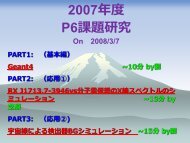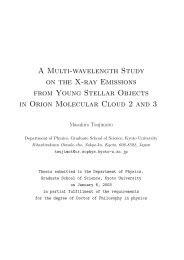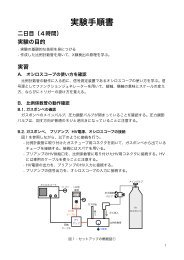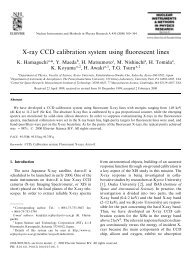X-ray Study of Low-mass Young Stellar Objects in the ρ Ophiuchi ...
X-ray Study of Low-mass Young Stellar Objects in the ρ Ophiuchi ...
X-ray Study of Low-mass Young Stellar Objects in the ρ Ophiuchi ...
Create successful ePaper yourself
Turn your PDF publications into a flip-book with our unique Google optimized e-Paper software.
84 CHAPTER 6. INDIVIDUAL SOURCES6.5.3 X-<strong>ray</strong> spectra and lum<strong>in</strong>ositiesFigure 6.20 shows <strong>the</strong> X-<strong>ray</strong> spectra <strong>of</strong> A-29, A-31, and BF-36 dur<strong>in</strong>g <strong>the</strong> flare phases and that<strong>of</strong> BF-36 <strong>in</strong> quiescent. We fit <strong>the</strong>m by <strong>the</strong> MEKAL model with <strong>the</strong> fixed abundance <strong>of</strong> 0.3 solar.However, reasonable constra<strong>in</strong>t can not be obta<strong>in</strong>ed on < kT > and N H with <strong>the</strong> limited statisticsfor A-29 and A-31. We hence fix <strong>the</strong> temperature at three typical values (1, 5, and 10 keV) <strong>of</strong> <strong>the</strong>o<strong>the</strong>r X-<strong>ray</strong> sources. The 1 keV temperature is typical <strong>of</strong> class II–III sources <strong>in</strong> quiescent, whilesome flares from class I–II sources have <strong>the</strong> 5 keV temperature and extremely high temperature<strong>of</strong> 10 keV is found <strong>in</strong> some giant flares; e.g., YLW16A = BF-64 (§6.1.5). Although all fitt<strong>in</strong>gsare acceptable, <strong>the</strong> assumed temperature <strong>of</strong> 1 keV gives uncomfortably high lum<strong>in</strong>osity <strong>of</strong> (4–7)×10 31 ergs s −1 , hence we discard <strong>the</strong> case <strong>of</strong> <strong>the</strong> 1 keV temperature. Table 6.6 shows <strong>the</strong> best-fitparameters, while <strong>the</strong> best-fit models (5 keV models for A-29 and A-31) are shown <strong>in</strong> Figure 6.20.For <strong>the</strong> quiescent phase <strong>of</strong> A-29 and A-31, we assume <strong>the</strong> same parameters as those <strong>of</strong> <strong>the</strong> flare.S<strong>in</strong>ce no significant X-<strong>ray</strong> is found <strong>in</strong> <strong>the</strong> quiescent phase for A-31, we estimate <strong>the</strong> 99.9 % upperlimit <strong>of</strong> <strong>the</strong> X-<strong>ray</strong> lum<strong>in</strong>osity (Table 6.6). The quiescent lum<strong>in</strong>osities are 2–30 times lower thanthose <strong>in</strong> <strong>the</strong> flare phases.Table 6.6: Spectral parameters <strong>of</strong> A-29, A-31, and BF-36No. Cts * < kT > < EM > ‡ N H‡< L X >(flare) ‡§ < L X >(quiescent) §(keV) (10 52 cm −3 ) (10 23 cm −2 ) (10 29 ergs s −1 ) (10 29 ergs s −1 )A-29 † . . . . . . . . . . . 21(5) 5 7.5(3.1–16) 2.5(1.3–4.7) 11 0.37· · · 10 5.0(2.1–10) 2.2(1.1–4.4) 8.1 0.27A-31 † . . . . . . . . . . . 10(2) 5 5.0(0.53–110) 5.4(1.5–20) 6.9 <strong>in</strong> <strong>the</strong> quiescent phase for A-29 and A-31 isderived with <strong>the</strong> assumption <strong>of</strong> <strong>the</strong> same absorption as that <strong>in</strong> <strong>the</strong> flare phase.‖ Derived by <strong>the</strong> simultaneous fitt<strong>in</strong>g <strong>of</strong> <strong>the</strong> flare and quiescent spectra.

















